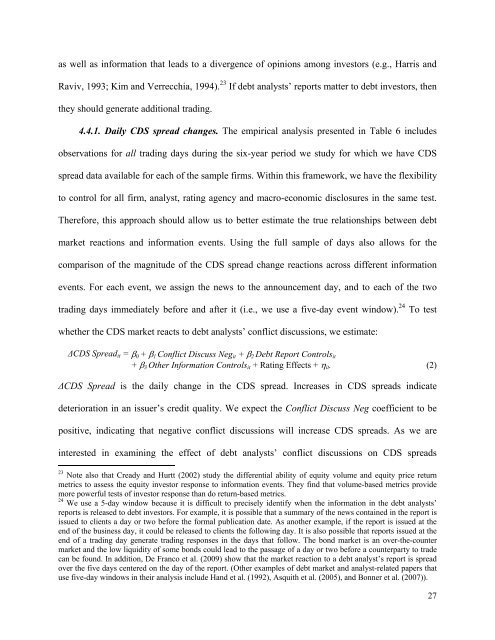Debt Analysts' Views of Debt-Equity Conflicts of Interest
Debt Analysts' Views of Debt-Equity Conflicts of Interest
Debt Analysts' Views of Debt-Equity Conflicts of Interest
You also want an ePaper? Increase the reach of your titles
YUMPU automatically turns print PDFs into web optimized ePapers that Google loves.
as well as information that leads to a divergence <strong>of</strong> opinions among investors (e.g., Harris and<br />
Raviv, 1993; Kim and Verrecchia, 1994). 23 If debt analysts’ reports matter to debt investors, then<br />
they should generate additional trading.<br />
4.4.1. Daily CDS spread changes. The empirical analysis presented in Table 6 includes<br />
observations for all trading days during the six-year period we study for which we have CDS<br />
spread data available for each <strong>of</strong> the sample firms. Within this framework, we have the flexibility<br />
to control for all firm, analyst, rating agency and macro-economic disclosures in the same test.<br />
Therefore, this approach should allow us to better estimate the true relationships between debt<br />
market reactions and information events. Using the full sample <strong>of</strong> days also allows for the<br />
comparison <strong>of</strong> the magnitude <strong>of</strong> the CDS spread change reactions across different information<br />
events. For each event, we assign the news to the announcement day, and to each <strong>of</strong> the two<br />
trading days immediately before and after it (i.e., we use a five-day event window). 24 To test<br />
whether the CDS market reacts to debt analysts’ conflict discussions, we estimate:<br />
ΔCDS Spreadit = 0 + 1 Conflict Discuss Negit + 2 <strong>Debt</strong> Report Controlsit<br />
+ 3 Other Information Controlsit + Rating Effects + it. (2)<br />
ΔCDS Spread is the daily change in the CDS spread. Increases in CDS spreads indicate<br />
deterioration in an issuer’s credit quality. We expect the Conflict Discuss Neg coefficient to be<br />
positive, indicating that negative conflict discussions will increase CDS spreads. As we are<br />
interested in examining the effect <strong>of</strong> debt analysts’ conflict discussions on CDS spreads<br />
23 Note also that Cready and Hurtt (2002) study the differential ability <strong>of</strong> equity volume and equity price return<br />
metrics to assess the equity investor response to information events. They find that volume-based metrics provide<br />
more powerful tests <strong>of</strong> investor response than do return-based metrics.<br />
24 We use a 5-day window because it is difficult to precisely identify when the information in the debt analysts’<br />
reports is released to debt investors. For example, it is possible that a summary <strong>of</strong> the news contained in the report is<br />
issued to clients a day or two before the formal publication date. As another example, if the report is issued at the<br />
end <strong>of</strong> the business day, it could be released to clients the following day. It is also possible that reports issued at the<br />
end <strong>of</strong> a trading day generate trading responses in the days that follow. The bond market is an over-the-counter<br />
market and the low liquidity <strong>of</strong> some bonds could lead to the passage <strong>of</strong> a day or two before a counterparty to trade<br />
can be found. In addition, De Franco et al. (2009) show that the market reaction to a debt analyst’s report is spread<br />
over the five days centered on the day <strong>of</strong> the report. (Other examples <strong>of</strong> debt market and analyst-related papers that<br />
use five-day windows in their analysis include Hand et al. (1992), Asquith et al. (2005), and Bonner et al. (2007)).<br />
27
















